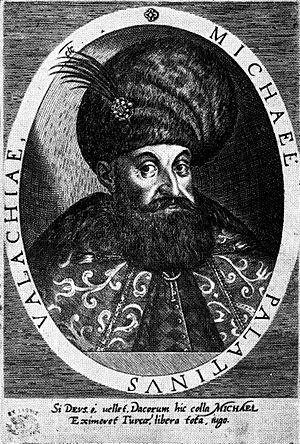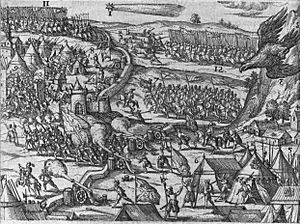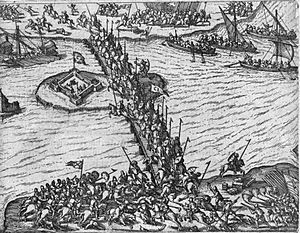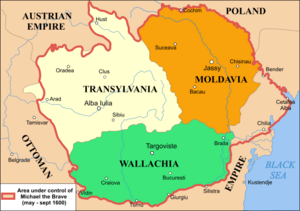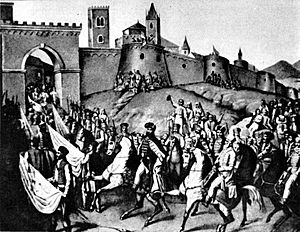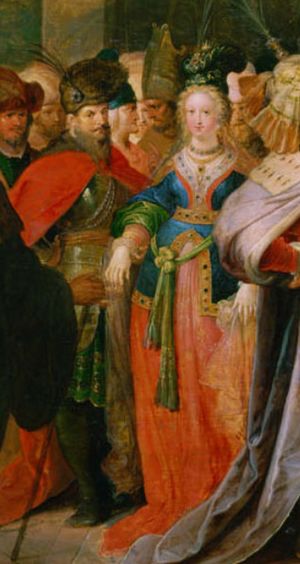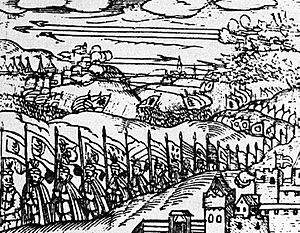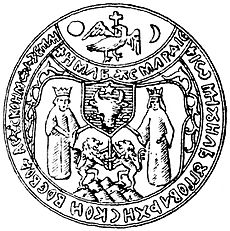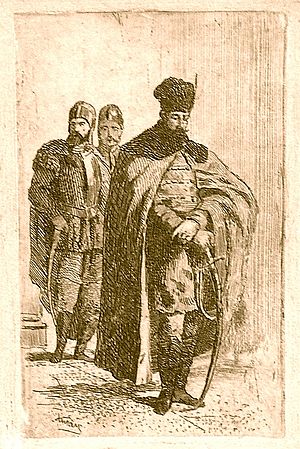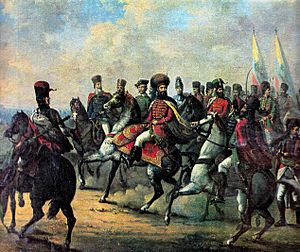Michael the Brave facts for kids
Quick facts for kids Michael the Brave |
|
|---|---|
| Prince of Wallachia Imperial governor of Transylvania Prince of Moldavia |
|
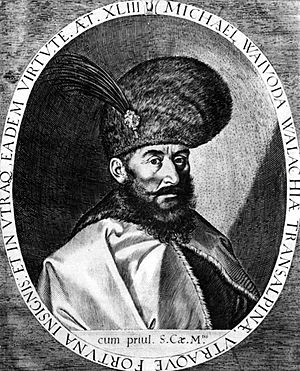
Portrait by Aegidius Sadeler II (Prague, 1601)
|
|
| Prince of Wallachia | |
| Reign | September 1593 – August 1601 |
| Predecessor | Alexandru cel Rău |
| Successor | Radu Mihnea |
| Prince of Transylvania (de facto) | |
| Reign | October 1599 – September 1600 |
| Predecessor | Andrew Báthory |
| Successor | Sigismund Báthory |
| Prince of Moldavia | |
| Reign | May – September 1600 |
| Predecessor | Ieremia Movilă |
| Successor | Ieremia Movilă |
| Born | Mihai Pătrașcu 15 January 1558 Târgul de Floci (near Giurgeni), Wallachia |
| Died | 9 August 1601 (aged 42–43) Torda, Principality of Transylvania (now Turda, Romania) |
| Burial | 12 August 1601 Alba Iulia or Bogata, Cluj County (body) Dealu Monastery, Dâmbovița County (head) |
| Spouse | Doamna Stanca |
| Issue | Nicolae Pătrașcu Domnița Florica |
| House | Drăculești |
| Father | Pătrașcu cel Bun |
| Mother | Teodora Cantacuzino |
| Religion | Orthodox Christian |
| Signature |  |
Michael the Brave (born Mihai Pătrașcu, 1558 – 9 August 1601) was a very important ruler in Romanian history. He was the Prince of Wallachia from 1593 to 1601. For a short time in 1600, he also ruled Moldavia and was the de facto (meaning "in practice") ruler of Transylvania.
Michael the Brave is seen as one of Romania's greatest national heroes. Many people in Romania believe he symbolizes Romanian unity. This is because his rule was the first time all the main areas where Romanians lived were under one leader.
Contents
Michael the Brave: A Romanian Hero
Michael's rule in Wallachia started in 1593. Two years later, a big war began with the powerful Ottomans.
Early Life and Rise to Power
Michael was born in 1558. Not much is known about his early childhood. Most historians believe he was the son of Pătrașcu cel Bun, a former Prince of Wallachia. His mother was Theodora Kantakouzene, from a noble family.
Michael quickly rose through the ranks in Wallachia. He became an important official, the Ban of Mehedinți, in 1588. By 1593, he was the Ban of Craiova, a very powerful position. However, he had problems with the ruler at the time, Alexandru cel Rău, and had to flee to Transylvania.
From Transylvania, Michael went to Constantinople (now Istanbul), the capital of the Ottoman Empire. With help from his family and friends, he convinced the Ottoman Sultan to make him the Prince of Wallachia. He officially became Prince in September 1593.
Fighting the Ottoman Empire
Soon after becoming Prince, Michael turned against the Ottoman Empire. He joined a Christian alliance of European powers who were fighting the Ottomans. He signed agreements with his neighbors: Sigismund Báthory of Transylvania, Aaron the Tyrant of Moldavia, and Emperor Rudolf II.
In the autumn of 1594, Michael began his fight against the Ottomans. He captured several forts along the Danube River, like Giurgiu and Brăila. His Moldavian allies also won battles against the Ottomans. Michael even pushed deep into Ottoman territory, reaching as far as Adrianople (modern-day Edirne).
The Battle of Călugăreni
In 1595, the Ottoman army, led by Sinan Pasha, prepared a huge attack. Michael's army was much smaller, so he chose to fight on a marshy field near the village of Călugăreni. The Battle of Călugăreni took place on 13 August. Michael bravely led his troops and defeated the much larger Ottoman army.
Even though he won, Michael had to retreat because his army was too small to fight the remaining Ottoman forces alone. He joined up with Sigismund Báthory's army and together they pushed the Ottomans back. They freed important towns like Târgoviște and Bucharest, temporarily making Wallachia free from Ottoman control.
The war against the Ottomans continued in 1596. Michael led several attacks south of the Danube. He even helped local Bulgarians during an uprising.
By 1597, a peace treaty was signed with the Ottomans. However, Michael knew it might not last. He asked Emperor Rudolf II for more support, and they signed a treaty in 1598. This treaty promised Michael money and supplies to keep his army strong. The war with the Ottomans started again, and Michael captured more towns. The fighting continued until 1599, when Michael signed another peace treaty because he lacked support to keep fighting.
Ruler of Transylvania
In 1598, Sigismund Báthory, the Prince of Transylvania, gave up his rule to Emperor Rudolf II, then changed his mind, and then gave it to his cousin, Andrew Báthory. Andrew Báthory was an ally of Michael's enemy, Ieremia Movilă, the Prince of Moldavia.
Andrew Báthory demanded that Michael give up his throne in Wallachia. Michael decided to attack Andrew Báthory first to stop an invasion. He marched his army into Transylvania.
Uniting the Lands
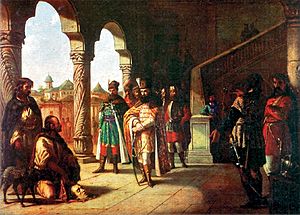
On 18 October 1599, Michael won a huge victory against Andrew Báthory's army at the Battle of Șelimbăr. This victory gave him control of Transylvania. Andrew Báthory was killed as he retreated, and Michael gave him a proper burial.
Michael then entered Alba Iulia, the capital of Transylvania. The local nobles recognized him as the ruler of Transylvania, under the authority of Emperor Rudolf II. Even though he was called an "imperial governor," he was truly in charge of Transylvania.
When Michael took control of Transylvania, he didn't immediately give new rights to the Romanian people living there, who were mostly peasants. He kept the old system that only recognized the rights of the Hungarians, Székelys, and Saxons. However, he did bring some of his Wallachian helpers to Transylvania and invited some Transylvanian nobles to help him rule Wallachia.
Becoming Prince of Moldavia
Ieremia Movilă, the Prince of Moldavia, was an old enemy of Michael. His brother, Simion Movilă, even claimed the throne of Wallachia for himself. Michael knew he had to deal with the Movilă family.
In April 1600, Michael met with Polish envoys. He offered to recognize the Polish King as his ruler if he could also become the Prince of Moldavia and pass on his rule of all three lands (Transylvania, Moldavia, and Wallachia) to his children.
Without waiting for a full agreement, Michael's troops invaded Moldavia on 14 April 1600. He reached the capital, Iași, on 6 May. The Moldavian army surrendered, and Ieremia Movilă fled. Michael was then declared the Prince of Moldavia.
During this time, Michael the Brave changed his official seal. It now showed symbols for Wallachia, Moldavia, and Transylvania, representing his personal union of these three lands.
However, Michael's success worried the powerful countries nearby: the Habsburg monarchy, the Ottoman Empire, and the Polish–Lithuanian Commonwealth. The Hungarian nobles in Transylvania also rebelled against him. With help from an Austrian general named Giorgio Basta, they defeated Michael at the Battle of Mirăslău. Michael was forced to leave Transylvania.
At the same time, a Polish army drove Michael's forces out of Moldavia and put Ieremia Movilă back on the throne. The Polish army also entered eastern Wallachia and made Simion Movilă the ruler there. Michael's loyal forces were left with control of only a small part of Wallachia called Oltenia.
His Final Battle and Death
Michael the Brave traveled to Prague to ask Emperor Rudolf II for help again. At first, the Emperor refused to see him. But when Emperor Rudolf heard that General Giorgio Basta had lost control of Transylvania to the Hungarian nobles, he changed his mind. Rudolf gave Michael money to rebuild his army.
Meanwhile, Michael's son, Nicolae Pătrașcu, led loyal forces in Wallachia. They drove Simion Movilă out and prepared to re-enter Transylvania. Michael, now allied with Giorgio Basta, defeated the Hungarian army at the Battle of Guruslău.
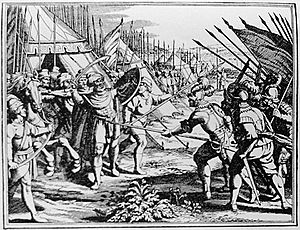
Just a few days later, on 9 August 1601, General Basta, who wanted to control Transylvania himself, had Michael killed. This sad event happened near Câmpia Turzii.
Why Michael the Brave is Remembered
Michael the Brave's rule, where he broke away from Ottoman control and led the three Romanian lands, is seen as a very important step towards modern Romania. Many Romanian nationalists see him as a symbol of unity and a hero who inspired the idea of a single Romanian state. He is known in Romanian history as Mihai Viteazul, which means "Michael the Brave."
His Famous Seal
Michael the Brave's special seal showed the symbols of Moldavia, Wallachia, and Transylvania. In the middle, it had the Moldavian aurochs (a type of wild ox). Above it was the Wallachian eagle, holding a cross. Below was the Transylvanian coat of arms, with two lions supporting a sword. This seal was a visual way to show that he ruled all three lands.
Honoring Michael the Brave
Many things in Romania are named after Michael the Brave, including towns and villages.
- Mihai Viteazu, a town in Cluj County
- Mihai Bravu, Giurgiu, a town in Giurgiu County
- Mihai Bravu, Tulcea, a town in Tulcea County
He is also remembered on Romanian money. His name and picture have appeared on coins, like the 100 Lei coin in the 1990s.
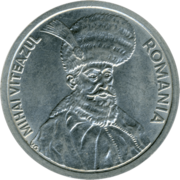
The Order of Michael the Brave is Romania's highest military award, named in his honor. Several important high schools in Romania also bear his name.
There is even a famous Romanian film called Mihai Viteazul, which tells the story of his life and his dream to unite the three Romanian lands.
See also
 In Spanish: Miguel el Valiente para niños
In Spanish: Miguel el Valiente para niños


